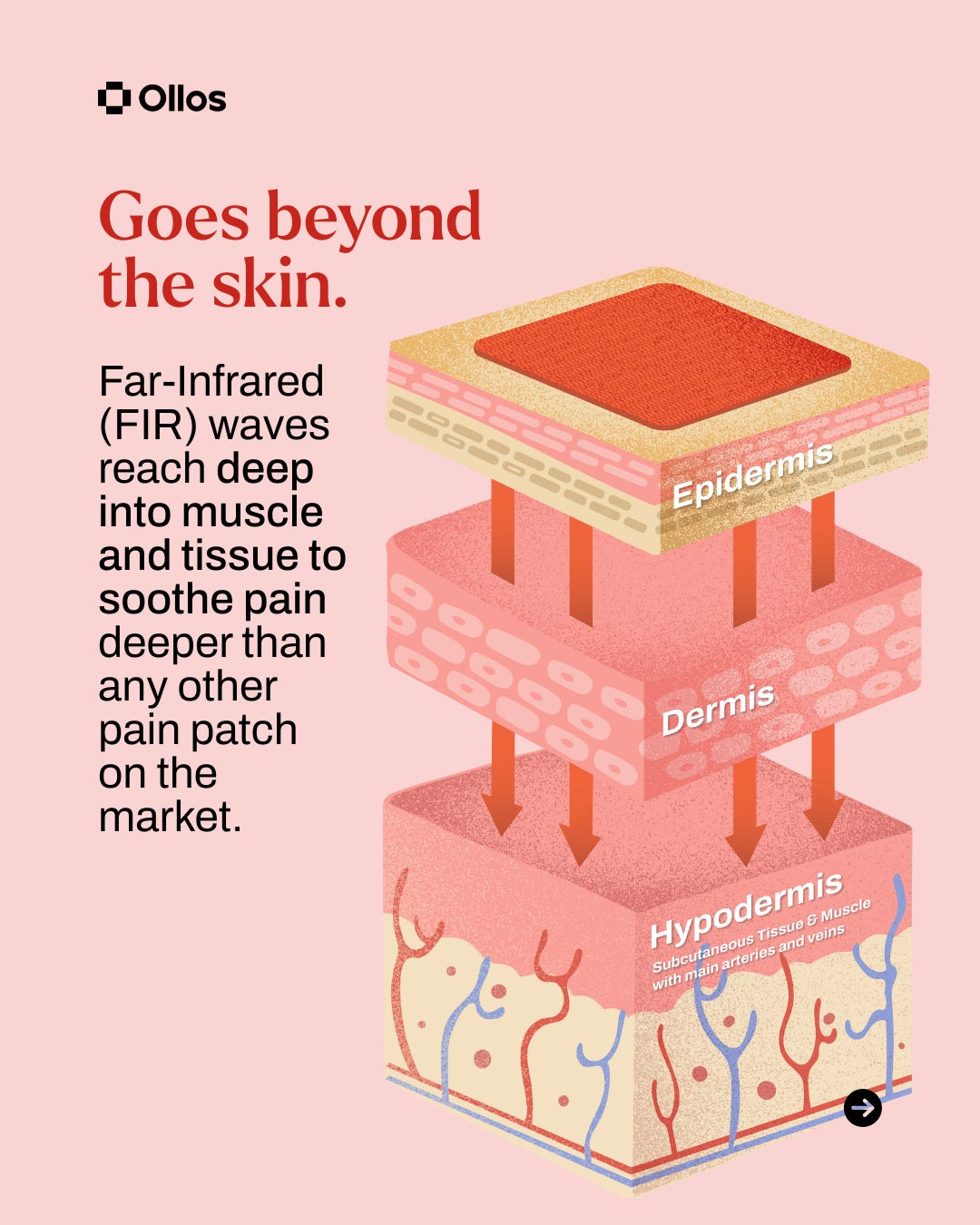The Science of Pain & Comfort: How Far Infrared Therapy Helps Pain Management & Healing
Pain is a common part of life, whether it’s from desk-related shoulder tension, stiff joints in the morning, or post-workout soreness that lingers longer than it used to. While traditional pain management methods often focus on masking discomfort, more people are seeking natural pain relief solutions that support the body’s healing process. Far infrared therapy is an innovative, science-backed approach that uses gentle, penetrating heat—similar to the sun’s warmth but without harmful UV rays—to promote pain relief, reduce inflammation, and enhance tissue healing.
At Ollos, we’re dedicated to making this therapy accessible through our portable pain relief solutions, helping you experience comfort and recovery anytime, anywhere. In this blog, we’ll explore the science behind far infrared therapy and how it can play a powerful role in your pain management journey.
Understanding Pain: More Than Just a Sensation
Pain isn’t just an inconvenience—it’s a complex biological signal that plays a crucial role in protecting the body. Understanding what causes pain begins with the body’s response to stress or injury: when tissues are damaged, specialized nerve receptors called nociceptors are activated, sending electrical signals to the brain that are interpreted as pain.
This pain response can be triggered by various factors:
Inflammation: Your body's natural response to injury or infection, causing increased blood flow, immune cell activity, and tissue swelling
Muscle tension: Sustained contraction that restricts blood flow and oxygen to tissues
Nerve pressure: Physical compression of nerves from surrounding tissues
Tissue damage: Direct harm to cells, prompting them to release chemicals that signal pain
Acute pain functions as a protective alert mechanism, whereas chronic pain, which lasts beyond the typical healing period, presents a more complicated issue. Recent research suggests pain involves changes in how pain signals are processed and can even alter nerve function over time [1].
What Is Far Infrared Therapy?
Far infrared therapy (FIR) refers to a specific range of the electromagnetic spectrum—invisible wavelengths of light that the human eye can’t see but the body perceives as soothing, penetrating heat. Unlike traditional heating methods that only warm the skin’s surface, far infrared waves penetrate 4–5 centimeters (about 1.5–2 inches) into the body, reaching muscles, joints, and tissues to support deeper healing [2]. This is made possible through a process called resonant absorption, where cells respond naturally to wavelengths between 6–14 microns.
Understanding how far infrared therapy works helps explain its growing popularity for natural pain relief, improved circulation, and tissue repair. While the benefits of far infrared therapy have been explored since the 1980s, modern research continues to uncover its powerful role in holistic wellness and pain management.
How Far Infrared Affects Your Body
When far infrared waves interact with the human body, they stimulate a series of therapeutic physiological responses that promote natural healing, pain relief, and overall comfort. This is one of the key benefits of far infrared therapy, as it works at the cellular level to enhance circulation, reduce inflammation, and support tissue repair—making it a powerful tool in holistic pain management.
1. Enhanced Circulation
One of the most well-documented effects of far infrared therapy is its ability to improve microcirculation—the blood flow through the smallest vessels in your body. Research demonstrates that FIR therapy can increase blood flow by up to 19.7% in treated areas, as confirmed by our clinical testing [9].
This circulation boost is crucial because:
It delivers more oxygen and nutrients to tissues
It accelerates the removal of metabolic waste products
It supports the body's natural inflammatory response
It helps transport repair cells to areas needing healing
Studies have shown that improvement in peripheral blood flow may be one of the key mechanisms behind FIR's therapeutic effects [3].
2. Muscle Relaxation
Muscle tension is a common source of discomfort, and FIR therapy appears particularly effective at addressing it. Research suggests that the soothing warmth of far infrared therapy may help ease muscle spasms and alleviate tension by lowering sympathetic nervous system activity, encouraging the body to transition from a 'fight or flight' state to one of 'rest and recovery.' [4].
This relaxation response:
Reduces the strain on tight muscles
Decreases compression on surrounding nerves
Improves range of motion
Creates a positive feedback loop that further reduces pain
3. Reduced Inflammation
While inflammation is a natural part of healing, persistent inflammation contributes to many chronic pain conditions. Recent research suggests that far infrared therapy can help modulate inflammatory responses at the cellular level [5].
This anti-inflammatory effect may work through several mechanisms:
Reducing the production of pro-inflammatory cytokines
Improving lymphatic drainage of inflammatory mediators
Supporting appropriate immune cell function
Promoting tissue repair processes that resolve inflammation
4. Pain Signal Modulation
One of the most compelling aspects of far infrared therapy is its potential to directly influence the transmission and perception of pain signals. A systematic review by Tsai et al. (2017) found evidence that FIR therapy influences the activity of pain receptors and the transmission of pain signals along nerve pathways [6].
By modulating these signals, far infrared may help:
Raise the threshold for pain perception
Interrupt the pain-tension-pain cycle
Provide lasting relief beyond the treatment period
Complement the body's natural pain management systems
From Science to Solution: The Evolution of Far Infrared Technology
Traditional far infrared therapy devices often rely on bulky equipment, electrical power sources, or visits to specialized clinics—making consistent use difficult and inconvenient for many, despite the proven benefits of far infrared therapy.
At Ollos, we’ve reimagined this approach with our patented bioceramic technology, which naturally emits far infrared radiation when activated by your body’s own heat. This innovation allows for a truly portable far infrared therapy solution, delivering effective, non-invasive at-home pain relief anytime, without the need for cords, plugs, or clinical visits.
Our proprietary formula combines:
Silica, providing structural strength at the nanoscale
Zinc oxide contributes to optimal emission wavelengths
Zirconia enhances the stability and efficacy of the compound
Through a specialized manufacturing process, these minerals undergo sintering processing and nano-refinement to create a powder that emits therapeutic far infrared wavelengths (8-14 μm) with remarkable efficiency, achieving an emissivity rating of 0.93 at normal body temperature [9].
This breakthrough allows us to deliver the benefits of far infrared therapy through convenient, portable patches that work wherever you go, without batteries, cords, or external power sources.
The Clinical Evidence
Our commitment to science-backed wellness means rigorous testing of our technology:
Independent laboratory testing by the Industrial Technology Research Institute confirms our material's far infrared emission performance, with an exceptional emissivity rating of 0.93 at 2-22 μm in the therapeutic wavelength range [9].
Human physiological testing conducted by the Taiwan Textile Research Institute demonstrates measurable effects after just 20 minutes of use [9]:
19.7% increase in blood flow volume
18.5% improvement in blood flow rate
0.9% increase in blood oxygen content
0.7°C increase in skin surface temperature
These measurements offer objective validation of the subjective relief many users report.
When and How to Use Far Infrared Therapy
Far infrared therapy shows particular promise for:
Muscle tension and stiffness: Particularly in areas like the neck, shoulders, and lower back
Joint discomfort: Including knees, hands, and other areas affected by activity or age
Post-exercise recovery: Supporting the body's natural repair processes
Daily wellness maintenance: As part of a proactive approach to comfort
The most effective approach often combines far infrared therapy with other healthy practices:
Appropriate movement and activity
Proper hydration
Stress management
Adequate rest and recovery
Unlike conventional treatments that only mask symptoms and may hinder the healing process, far infrared therapy offers a safe, effective approach that supports your body’s natural ability to self-repair. By working in harmony with your body’s natural healing processes, far infrared therapy provides lasting natural pain relief and helps to promote healing naturally without harmful side effects.
The Future of Healing
As advances in pain science deepen our understanding of the body’s healing mechanisms, natural pain management and holistic healing approaches that respect and support the body’s inherent processes are gaining increased attention from researchers and healthcare providers alike.
A comprehensive review by Shui et al. (2015) concluded that far infrared therapy represents "a promising non-invasive treatment" for various conditions involving circulation, inflammation, and tissue recovery [7]. Similarly, research by Chien et al. (2021) highlights the potential of FIR in supporting the body's natural regulatory and healing mechanisms [8].
While ongoing far infrared therapy research is needed, current evidence highlights its potential as a valuable component of a comprehensive wellness approach focused on lasting comfort and healing. At Ollos, we are committed to advancing this innovative science and making its powerful benefits accessible for everyday use. By supporting your body’s natural healing abilities, our solutions promote true comfort and effective natural pain relief, going beyond symptom masking to foster an environment where holistic wellness can thrive.
Note: While far infrared therapy shows promise for supporting comfort and wellness, it is not intended to diagnose, treat, cure, or prevent any disease. Individual results may vary. For medical concerns, please consult with a healthcare professional.
References
Pinheiro ESdS, Queirós FCd, Montoya P, Santos CL, Nascimento MAd, et al. (2016) Electroencephalographic Patterns in Chronic Pain: A Systematic Review of the Literature. PLOS ONE 11(2): e0149085. https://doi.org/10.1371/journal.pone.0149085
Vatansever, F., & Hamblin, M. R. (2012). Far infrared radiation (FIR): Its biological effects and medical applications. Photonics & Lasers in Medicine, 1(4), 255-266. https://pmc.ncbi.nlm.nih.gov/articles/PMC3699878/
Lai, Y.T., Chan, H.L., Lin, S.H., Lin C.C., Li, S.Y., Liu, C.K., Teng, H.W., Liu, W.H. (2017). Far-infrared ray patches relieve pain and improve skin sensitivity in myofascial pain syndrome: A double-blind randomized controlled study. Complementary Therapies in Medicine, Volume 35. Pages 127-132, ISSN 0965-2299. https://doi.org/10.1016/j.ctim.2017.10.007
Beever, R. (2009). Far-infrared saunas for treatment of cardiovascular risk factors: Summary of published evidence. Canadian Family Physician, 55(7), 691-696. https://pubmed.ncbi.nlm.nih.gov/19602651/
Lai, Y. T., Chan, H. L., Lin, S. H., Lin, C. C., Li, S. Y., Liu, C. K., Hong, C. F., Yang, B. X., & Chan, W. P. (2014). Far infrared ray irradiation attenuates inflammatory response and oxidative stress in primary human chondrocytes. Journal of Photochemistry and Photobiology, 134, 26-33.
Tsai, S. R., & Hamblin, M. R. (2017). Biological effects and medical applications of infrared radiation. Journal of photochemistry and photobiology. B, Biology, 170, 197–207. https://doi.org/10.1016/j.jphotobiol.2017.04.014
Shui, S., Wang, X., Chiang, J. Y., & Zheng, L. (2015). Far-infrared therapy for cardiovascular, autoimmune, and other chronic health problems: A systematic review. Experimental biology and medicine (Maywood, N.J.), 240(10), 1257–1265. https://doi.org/10.1177/1535370215573391 (Retraction published Exp Biol Med (Maywood). 2020 Aug;245(14):NP1. doi: 10.1177/1535370220940656.)
Chien, S. C., Tu, H. P., Wang, F. J., Yeh, Y. C., Cheng, H., Tsai, C. C., Tsai, M., Lan, S. J., & Wang, Y. C. (2021). The potential therapeutic effects of far-infrared therapy on chronic diseases and cancer. International Journal of Molecular Sciences, 22(20), 11201.
Ollos Research & Testing. (2024). Internal laboratory testing and clinical validation of far infrared technology. https://www.ollos.co/pages/research-testing




